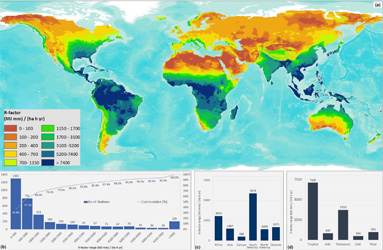Exploring the Power of Recent Rainfall (Erosivity) Events on a Global Scale
Submitter: Nazzareno Diodato, Met European Research Observatory
Area of Research: Global scale hydroclimate of power of rainfall (erosivity)
GEWEX Panel: GEWEX Hydroclimatology Panel (GHP)
Journal Reference:
Panagos P., Borrelli P., Katrin Meusburger, Bofu Yu, Andreas KlikKyoung Jae Lim, Jae E. Yang, Jinren Ni, Chiyuan Miao, Nabansu Chattopadhyay, Seyed Hamidreza Sadeghi, Zeinab Hazbavi, Mohsen Zabihi, Gennady A. Larionov, Sergey F. Krasnov, Andrey V. Gorobets, Yoav Levi, Gunay Erpul, Christian Birkel, Natalia Hoyos, Victoria Naipal, Paulo Tarso S. Oliveira, Carlos A. Bonilla, Mohamed Meddi, Werner Nel, Hassan Al Dashti, Martino Boni, Nazzareno Diodato, Kristof Van Oost, Mark Nearing, Cristiano Ballabio, 2017. Global rainfall erosivity assessment based on high-temporal resolution rainfall records. Scientific Report, 7, 1-12. DOI: 10.1038/s41598-017-04282-8.
Science:
The patterns of heavy and violent rainfall, as captured by the rainfall erosivity factor, influence hydrological and erosive processes and as such are essential for the definition of soil and water conservation practices in the adaptation of agriculture to climate change. Rainfall erosivity is one of the most important input parameters for describing erosive processes and proposing conservation measures by using soil erosion prediction models.
Impact:
In this study, we aim to tackle the challenging task of compiling and processing the first global erosivity dataset from long-term high-resolution rainfall data using sub-hourly and hourly pluviographic records. We have used this global erosivity station dataset combined with a set of exhaustive secondary environment variables to generate a global rainfall erosivity map in order to improve our understanding of the global patterns of high intensity rainfall events.
Summary:
Heavy rainfall and extreme events are of major importance for climate change, economy and society. However, extreme events, as involved in rainfall erosivity phenomena, are typically rare events of short duration and in many regions of the world only limited observational data of sufficient temporal resolution is available to capture them. In this way, rainfall erosivity is one of the most important input parameters for describing erosive processes and proposing conservation measures by using soil erosion prediction models. While water erosion is identified as the most serious cause of soil degradation globally, global patterns of rainfall erosivity remain poorly quantified. We present the results of an extensive global data collection effort whereby we estimated rainfall erosivity for 3,625 stations covering 63 countries. This first ever Global Rainfall Erosivity Database was used to develop a global erosivity map at 30 arc-seconds (~1 km) based on a Gaussian Process Regression(GPR). Globally, the mean rainfall erosivity was estimated to be 2,190 MJ mm ha-1h-1yr-1, with the highest values in South America and the Caribbean countries, Central east Africa and South East Asia. The lowest values are mainly found in Canada, the Russian Federation, Northern Europe, Northern Africa and the Middle East. The tropical climate zone has the highest mean rainfall erosivity followed by the temperate whereas the lowest mean was estimated in the cold climate zone.
Link to the Original Research Publication or Website: https://www.nature.com/articles/s41598-017-04282-8


